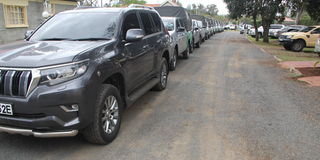Why leasing is now a trillion dollar business

Some of the 21 vehicles that have been lying at the compound of Laikipia Governor's office and which were driven back to Toyota Kenya Limited Yard after termination of a five-year-leasing contract.
To the untraveled, only their mums know how to cook, so goes a saying among the Agikuyu. In this final part in defence of leasing, I examine the size and structure of the sector.
The Leasing Global Market Report 2022 by Research and Markets estimates the global leasing market at $1.5 trillion, growing at 12 percent per year.
The Competition Authority of Kenya (CAK) published the results of a market inquiry into the leasing industry a couple of years ago.
The public version of the report is available online. And although redacted for confidentiality reasons, it offers useful insights.
The report estimates the value of the leasing sector in Kenya at Sh54 billion, dominated by the national government and large corporates.
Among counties, Laikipia had showed early promise, but has since been having second thoughts.
The Leasing Association of Kenya has 39 members, among them leading banks and their associated companies.
The list includes suppliers of vehicles and equipment and half a dozen specialist leasing companies. Including hire purchase, the most regularly leased assets are trucks and cars.
Some leasing companies have, however, expanded service to include supermarket fittings and equipment.
Finance experts encourage that you match the term of financing with the useful economic life of an asset. For instance, they would frown on using an overdraft to finance a building or factory machinery.
Another way to think about this matching concept is the pay-back period. How long will it take to re-coup the investment? When you buy a lathe machine, or a truck, it will take several years, often between three and five to re-coup the original investment. Therefore, you need medium-term finance.
Poor access to finance is a major road block for Kenyan SMEs. Various policy responses have been tried, including forming specialist institutions such as Kenya Industrial Estates, and recently Kenya Development Corporation (KDC). The latter resulting from a merger of ICDC, IDB Capital and the Tourism Fund.
Still, these policy responses have not succeeded in availing appropriate affordable capital at a large scale, and SME development remains stunted. The results of the FinAccess studies show that general access to formal finance such as having a bank or mobile money account has improved rapidly, reaching 84 percent of the adult population last year, up from 46 percent ten years earlier.
However, welfare has been declining. That is because productivity is either stagnant or declining. Put differently, SMEs are not able to invest in machinery and equipment. Well, you cannot equip a furniture or welding workshop using an overdraft facility such as Fuliza.
Leasing is the right product to support such medium-term finance needs of counties and small businesses across all sectors, particularly because the leased asset is collateral security itself.
The CAK inquiry concluded that the problem of the SME leasing market is a lack of commercial incentive for banks and lessors to invest in and develop the SME leasing market.
It also found that by handling one asset at a time, SME leasing has high transaction costs and low marginal returns. In comparison large corporates and the national government lease numerous assets at a time, creating efficiencies of scale.
These customers have or can get the expertise to understand leasing. In comparison, SMEs and counties lack understanding of leasing and so require the legal, fiscal and accounting treatment of leasing to be explained one customer at a time. The resulting high transaction costs makes the market unattractive.
@NdirituMuriithi is an economist





